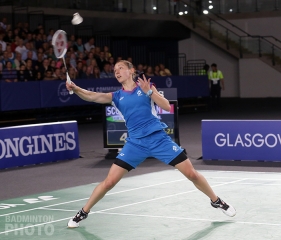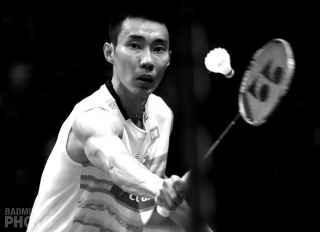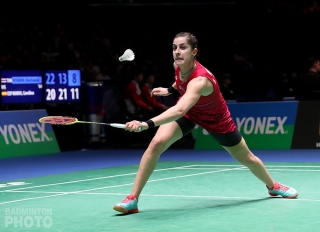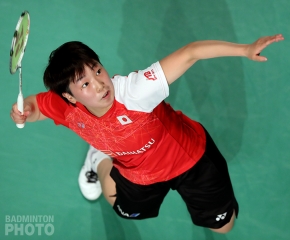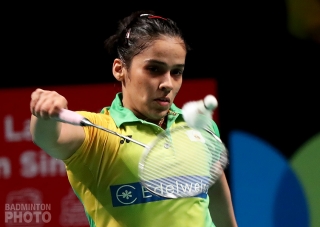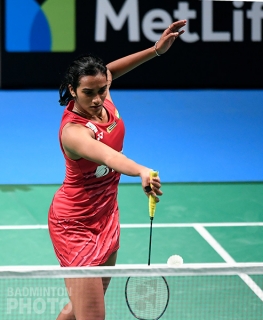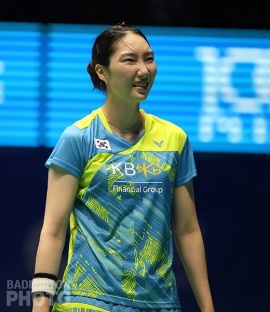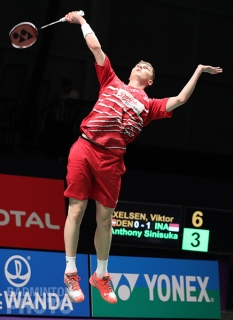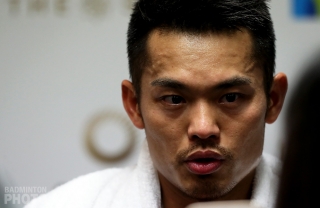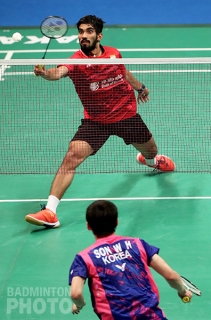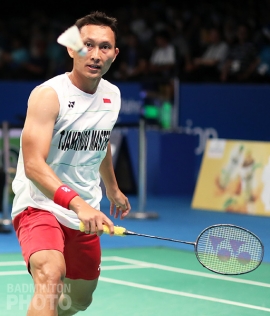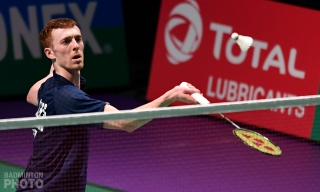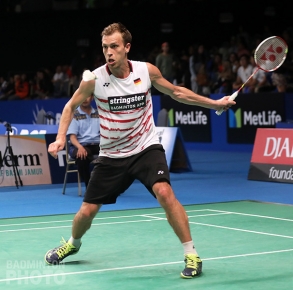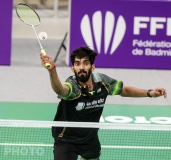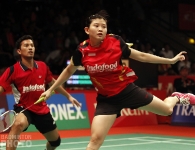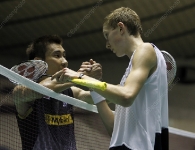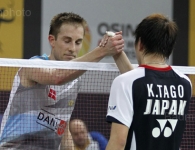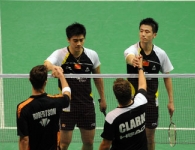The World Championships comes to Scotland again for its 23rd edition. What can possibly top the Guinness World Record on finals day from two decades ago? Our preview specialist Aaron Wong delves into the draw and reflects on key developments in badminton.
Photos: Badmintonphoto
Glasgow hosted badminton’s tenth World Championships. Back then the event was biennial and the Siamese twin sister of the Sudirman Cup in what was a busy competition fortnight. It concluded on a high note with a 124-minute (2-hour-and-4-minute) men’s singles final. In 2017, another chance at a maiden Worlds title to better three times (four if you count his 2014 disqualification) stopping short in the final looms large in spectators’ imaginations for world #2 Malaysian Lee Chong Wei (pictured below).
Adapt or die
The World Championships is a useful point in time marker, like the Olympics. Three developments have come to light in the last nine years or post-Beijing Games.
The prowess to adapt in the singles events is more crucial than ever. Strokes, strategy, and fitness are aspects an athlete can refine endlessly. But what happens on the competition court is immensely outside one’s control and adapting swiftly to unpredictability in all its guises is the new frontier for personal improvement.
Television badminton commentator Steen Pedersen has spoken of the myriad variables unseen by spectators that that players must adjust to, the most commonly known being drift in the stadium to speed of shuttles, and climate. You can add to this list crowd noise, gamesmanship, over-reliance on coaching, certain opponent’s war cries, and talking to the umpire.
For players, all this boils down to either distraction or constant extra geometric calculation. At this year’s Australian Superseries, Lin Dan stated that adjusting soon into every match is prime on his mind.
Relevance of this important habit can be extrapolated to incidents that occur at any moment. Several examples stand out where players were nearing victory only for their diligent efforts to evaporate because of the unexpected and then not being able to refocus in time to salvage the deficit. Wang Shixian received a red card and was left utterly shaken in the closing minutes of the 2016 All England women’s singles final. Fast forward to Birmingham this March to observe lack thereof as well as cultivating of the habit when Carolina Marin (pictured) worried herself inexorably into submission as Ratchanok Intanon wiped out the Spaniard’s 18-11 rubber lead.
Call it intra-match adjustment aptitude or recomposing oneself but getting better at this is the ability you cannot afford not to have. Now try rewatching the London Olympic final where Lee Chong Wei diligently led the majority of the rubber only to have his score halt at 19-18 through this newfound prism of knowledge to truly appreciate the major shift in thought leadership.
Where does the time go?
Adaptability can also be taken to mean the wave of innovation in technique and constant problem solving as happened in women’s singles during the rise in prominence of Carolina Marin and reaching the height of concentration in the Rio Olympic year.
Women’s events have transformed into exceedingly tight affairs in terms of athletic efficiency. The broad skills on display by the current top 10 singles proponents is in excess of those personnel from previous decades (which should not to be confused with comparing players’ innate abilities across different eras).
Look at Marin and Akane Yamaguchi (pictured) in action and notice how there is hardly any dead time in executing a shot. The best illustration of this contrast is to rewatch footage of a top Japanese singles player from last decade such as Eriko Hirose. Japanese women have routinely been fast at travelling to the shuttle and this timing is quite likely still comparable. The development has been in compacting the time and technique of the shot production phase – the footwork lands to re-balance centre of gravity sooner as well as hand strokes following with negligible delay.
Mind the gap I
In several disciplines, namely men’s singles, there is an unprecedented growing gap in the ages of the best players because Lin Dan, Lee Chong Wei and Lee Hyun Il continue to hover inside and around the top 10. Every year this phenomenon continues on is breaking new ground for the sport of badminton and ought not be taken for granted. It speaks of advancements in energy saving ploys among other qualities. For the women, Saina Nehwal (pictured) exemplifies change in style during her career which came as a second wind and surprised others of her generation – like Wang Yihan and Li Xuerui – how drastically her shots changed to incorporate elements of the latest developments while theirs had not.
Women’s singles: 16 and 16
16 seeds and 16 byes in women’s singles means the bar on Day 1 doesn’t start high and go higher like at a Superseries. Any seed plotting a route to the finish line has at most one unpredictable hurdle rather than multiple.
Based on technical innovation over the past year and still continuing at it, the leading light is top seed Akane Yamaguchi of Japan. Nobody else has improved as much and she has arguably advanced more so in percentage change than the absent world #1 Tai Tzu Ying, who chose the Taipei Universiade over Glasgow.
Mind the gap II
Yamaguchi’s quarter-final rendezvous with Ratchanok Intanon would normally be trickier if the former Thai world #1 was back to her sweetest timing on shots. The semi in the top half is of greatest interest because tall Pusarla Venkata Sindhu (pictured) with her quick reactions and odd turn in the wrist technique is Yamaguchi’s kryptonite.
So much of the innovation in women’s singles since the Beijing Olympics has led to closing the gap between tall and short physiques but it never totally erases the natural advantage of extra height. During the 21-points rally scoring era, all the best top short players (Pi Hongyan, Xu Huaiwen, Mia Audina, Bae Yeon Ju, Saina Nehwal) struggled to find any solutions to counter Xie Xingfang’s long and lanky reach, with only Tracey Hallam and Wong Mew Choo recording the odd win.
Sindhu’s nemesis is ironically a tall player most of the current short stars have figured out how to beat, namely China’s Sun Yu. Their quarter-final bout is probably the biggest determining factor in Yamaguchi’s fate.
Even without considering she’s done it before, Scotland can cause an upset in the bottom half when the feisty Kirsty Gilmour (pictured top) takes on He Bingjiao, who has shown signs of a slump. There’s home support for Gilmour to add to that.
India’s Saina Nehwal is the women’s seed for whom the draw has done the most favours because ahead are adversaries she has a good record over, beginning with second-seeded Korean Sung Ji Hyun (pictured). If good records prevail as the order of the week in the bottom draw, all the stylistically troublesome opponents for Nehwal are removed by opponents she finds manageable. On the other hand, reigning World and Olympic champion Carolina Marin receives the opposite luck and gets to be tired out by Sayaka Sato and no matter which lady becomes the victor it only helps Nozomi Okuhara’s cause in their tussle at the quarters. Going through, Okuhara has lesser odds against Nehwal for a possible semi.
Due to rejuvenation post-surgery, 27-year-old Nehwal, runner-up at the previous World Championship, is currently neither at her fullest nor worst form. Yet, she undoubtedly harbours a more intense offensive, greater reach on shuttles, and no reduction in strong will on court than during her early twenties when she was more feted and earned Olympic bronze in Beijing. In short, she would beat her younger optimum self and this accumulated wisdom, combined with an ideal draw, may well usher her all the way in the tournament despite lack of fanfare lately.
Early women’s singles matches of interest
Likely Rd 2: Nozomi Okuhara (JPN) [7] vs. Iris Wang (USA)
Likely Rd 3: Carolina Marin (ESP) [3] vs. Sayaka Sato (JPN) [10]
Upset potential (likely Round 3 matches)
Kirsty Gilmour (SCO) [16] vs. He Bingjiao (CHN) [6]
Saina Nehwal (IND) [12] vs. Sung Ji Hyun (KOR) [2]
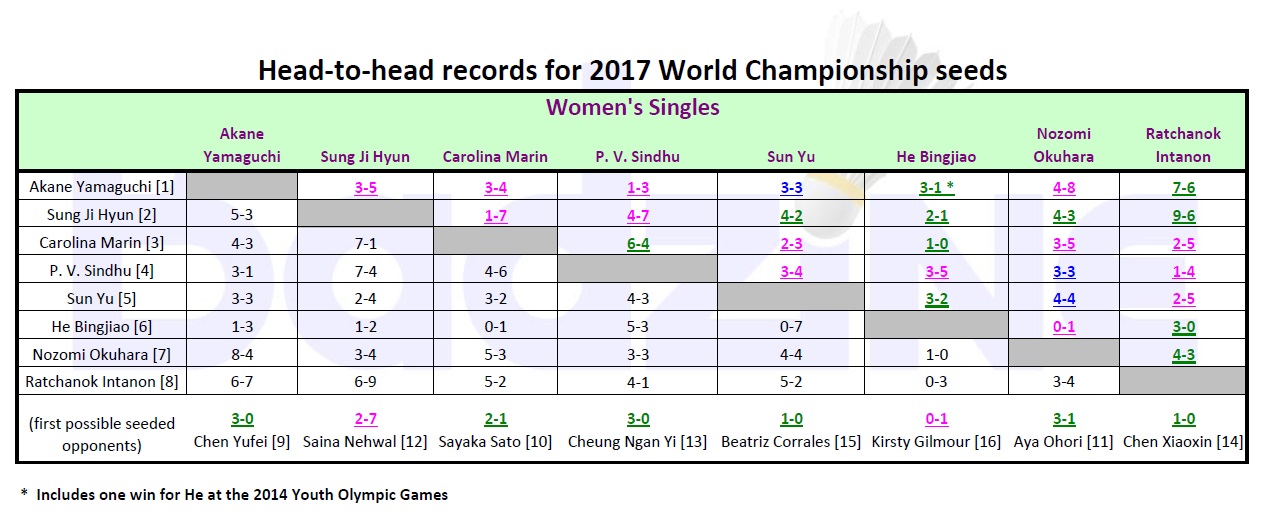
How the top eight seeds stack up against one another and against their respective first possible seeded opponents in the 3rd round. Click on the image to see a .pdf version with links to the individual head-to-head pages on tournamentsoftware.
Men’s singles: One of the four
Given how they are actually playing instead of number of Superseries finals, there is no consistently outright dominant man in singles so far this year because a lot of top players haven’t faced each other. However, four of those five Superseries winners – Srikanth Kidambi, Lin Dan, Lee Chong Wei, and Viktor Axelsen – are impossible to overlook as equal front-runners.
Viktor Axelsen (pictured) portrays the ultimate exacting millennial approach to sports by making scientific improvements in all parts of his preparation and court game. Some gymnastics elements are incorporated into flexibility training, strokes are meticulously groomed for efficiency along similar lines to the aforementioned progress in women’s singles. The highest ranked Dane is a dedicated learner from past experiences which bodes well.
Lee Chong Wei’s present quality relative to his best is difficult to determine precisely. At the 2016 Malaysian Superseries, he was on fire and last observation was of flame turned lower, presumably as a precaution since reportedly twisting his knee during training earlier in the year, yet he still scorched all opponents except for three losses year to date – twice to Lin Dan and once to H.S. Prannoy. As ever, any weight of expectation upon him to convert one World title is hardly helpful.
Is Lin Dan greater than 007?
The ‘lucky’ men’s singles seed is the G.O.A.T. Lin Dan (pictured), who last won the world title at Guangzhou 2013. Can seventh seeded Lin pull off a James Bond caper? Just this week Daniel Craig revealed to everybody’s absolute surprise that he is returning as 007 for a fifth outing. Stranger things can happen and based on the draw it isn’t a stretch to imagine Lin outdoing Craig’s count with a sixth World Championship victory.
The seeded threat in Lin’s quarter is comrade Shi Yuqi and aficionados well know that 007s possess insider advantage of disposing of other 00s. The unseeded threat, potentially a round before meeting Shi, is India’s Sameer Verma, who has improved as much as Superseries finalist status. However, he remains light on both experience and wins over Chinese opponents at nil so far this year and four losses out of five since early 2015.
Of the formidable foes around, Lin would mind the least meeting world #1 Korean Son Wan Ho at the semi-final because relatively speaking there’s always still time to adjust against a defensive type. The feeling is probably mutual for Son as Lin isn’t the biggest hitter or highest jump smasher or most energetic or all the above qualities in a seeded opponent to deal with. Son has the second best draw in the top half with vision through to the quarters.
Preferable for whom?
Srikanth Kidambi (pictured), the hottest player of 2017 (as well as 2014) with the luckiest seed number, 8 (luckiest in Chinese culture at least), could be the alternative facing Lin at the semis. This scenario is less preferable for Lin’s fortunes but makes for gripping drama as Srikanth proceeding further and further offers intriguing contrasts at each turn.
Will twenty-year-old Anders Antonsen do Lin and Son a favour and take care of Srikanth? Denmark’s third highest ranked has the toughest draw for a top half seed. It’s possible. 2017’s upstart is due to collide with 2014’s upstart in Round 3 for a first time encounter. Srikanth facing Son, in another exhibition of polar opposite attacking styles, would make it their third high profile encounter this year and the outcome is not a given despite the Indian having won on both previous occasions. Not only has it required securing the rubbers but necessarily warming to full heat on the day for Srikanth to beat a standard Son.
Depending on what you appreciate from following badminton, a step beyond pits together men with a nine-year age gap and gets the older superhero to either reprove his contemporary relevance or there’s witnessing the wonderment and nitty-gritty of how the technique of a legend must continually mature to get the job done.
Indonesian interceptions
The delights in the bottom half of the draw include Sony Dwi Kuncoro (pictured left) playing Chen Long as early as the second round. It’s a long shot to shoot down a reigning Olympic champion but this is an interesting stage of the Indonesian’s career where he is older, keen to play after the injury wilderness years, yet wins or loses against anybody solid. Therefore, it’s better not to waste the 2007 World Championship runner-up’s few good days and fine skills on chasing down the shuttles of young athletic men. Lee Chong Wei ahead at the quarters also fits the bill nicely.
Spectators love the birth of a great rivalry and fate has it that Kuncoro’s compatriot Anthony Ginting should once more be forced into a producing a Harry Houdini escape from the clutches of the much taller men who helped bring him fame. Viktor Axelsen awaits him at the quarters and Chen Long at the semis.
Warming up or dressing down
For stars and seeds, the Goldilocks zone of the opening round is getting to play somebody good enough to warm one up thoroughly without the match sliding into nightmare territory. With 16 seeds ruling out any Superseries winner encounters as openers, the early thrills in the tournament lies in the hands of experienced – if not elder – European statesmen paying little regard to the odds stacked against them. A few from this subset of the European cast were runner type players in their youth and have obviously stayed rather fit in addition to incorporating energy-saving ways since.
Singles players make opponents use up all their energy so it can be disconcerting to find oneself against somebody past his spring who is happily willing to keep pace judiciously. They’re older and still competing for good reason.
Local lad Kieran Merrillees (pictured above) is unlikely to be overawed as he commands sufficient singles game sense and confidence to deliver on his own plans in warming up one of the sentimental favourites, Lin Dan. This should afford Lin an ideal feel for the court and his own timing.
The other sentimental favourite ought to beware, Brice Leverdez executes a few stunning early scalps per year. Although a few years younger than second seed Lee Chong Wei, the 29-year-old Frenchman is also a veteran of the tour and sent the Malaysian packing from Odense in 2016.
Marc Zwiebler (pictured), on the cusp of retirement, continues to prowl with the highly developed instincts of a top 10 calibre player and remains quite capable of dispatching the sixth seed from Chinese Taipei on Day 1. In a meeting of the minds, 10th seed Tian Houwei and Hans-Kristian Vittinghus understand that each is committed to running both sides into the ground to advance into Round 2.
Early men’s singles matches of interest (Round 1)
Lin Dan (CHN) [7] vs. Kieran Merrilees (SCO)
Sameer Verma (IND) vs. Pablo Abian (ESP)
Sai Praneeth B (IND) [15] vs. Wei Nan (HKG)
Tian Houwei (CHN) [10] vs. Hans-Kristian Vittinghus (DEN)
Lee Chong Wei (MAS) [2] vs. Brice Leverdez (FRA)
Upset potential (likely Round 2)
Kanta Tsuneyama (JPN) vs. Wong Wing Ki (HKG) [12]
Marc Zwiebler (GER) vs. Chou Tien Chen (TPE) [6]
Sony Dwi Kuncoro (INA) vs. Chen Long (CHN) [5]
Click here for the complete draws
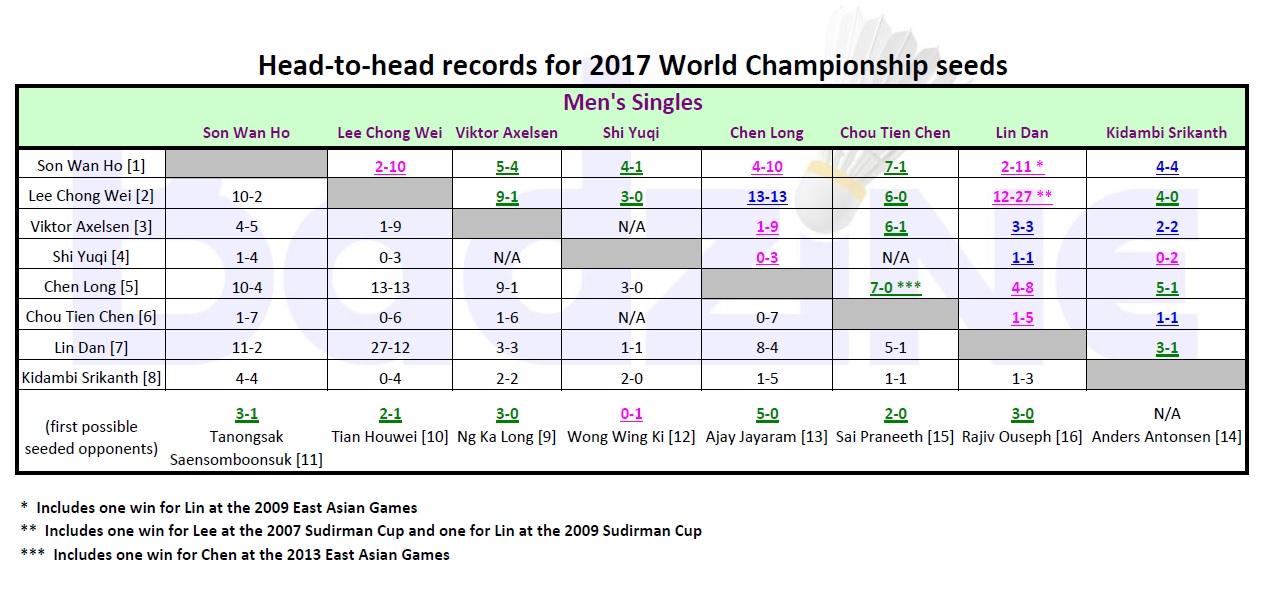
How the top eight seeds stack up against one another and against their respective first possible seeded opponents in the 3rd round. Click on the image to see a .pdf version with links to the individual head-to-head pages on tournamentsoftware.
![WORLDS Preview Part 1 – Singles: The Glasgow sequel The World Championships comes to Scotland again for its 23rd edition. What can possibly top the Guinness World Record on finals day from two decades ago? Our preview specialist Aaron […]](http://www.badzine.net/wp-content/uploads/ngg_featured/20170521_1327_SudirmanCup2017__SUD0676_rotator.jpg)
